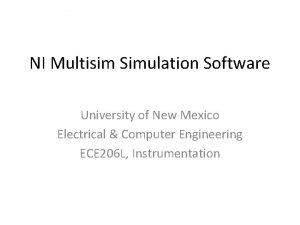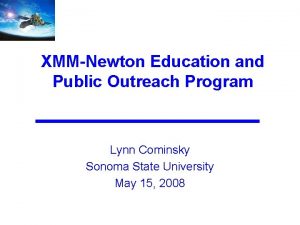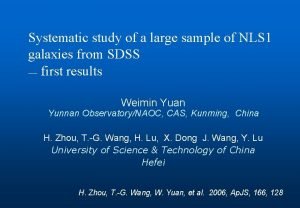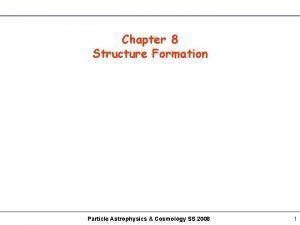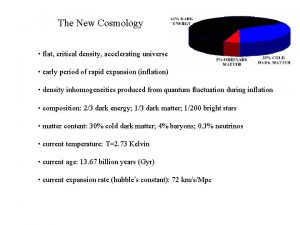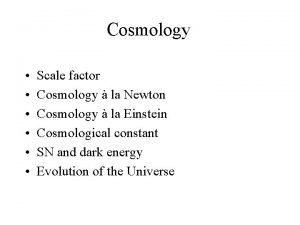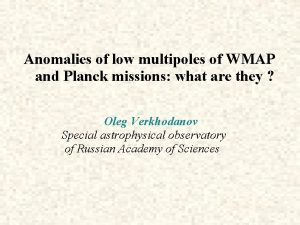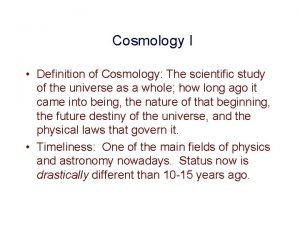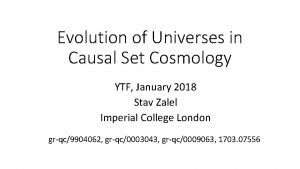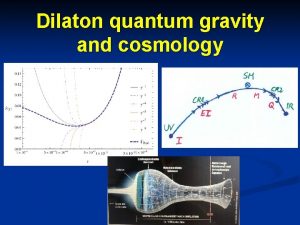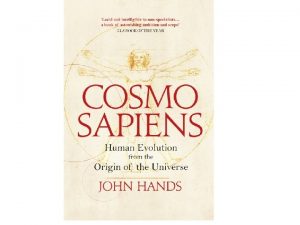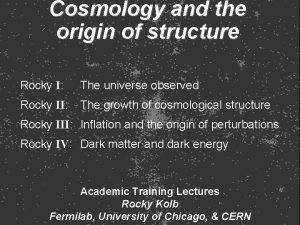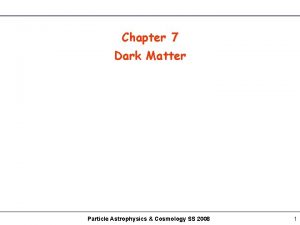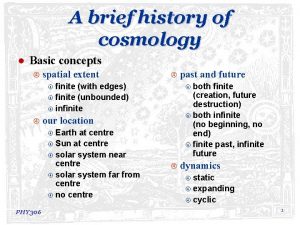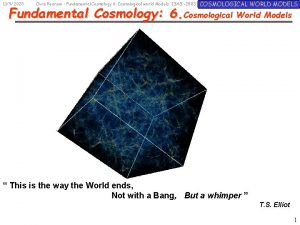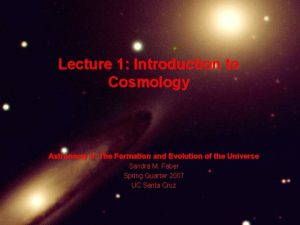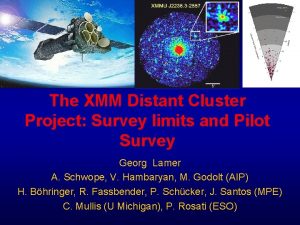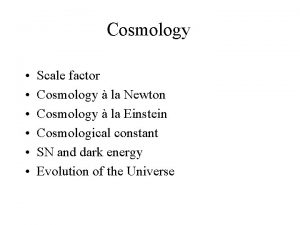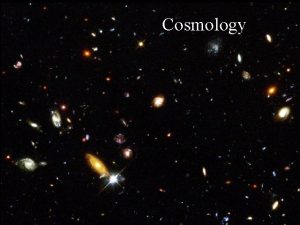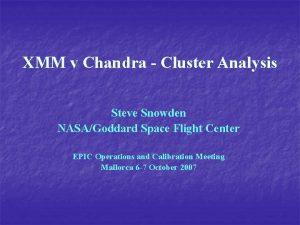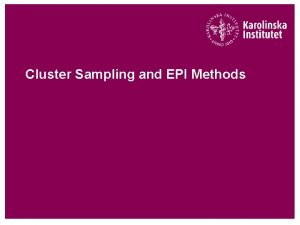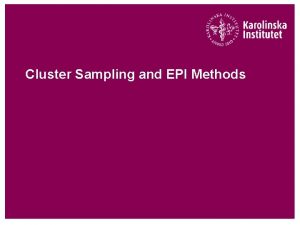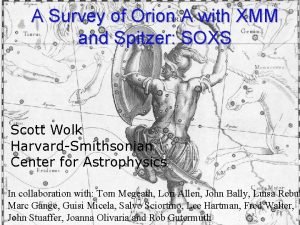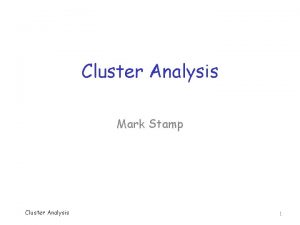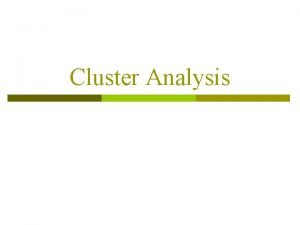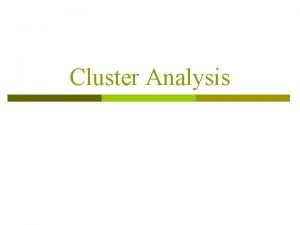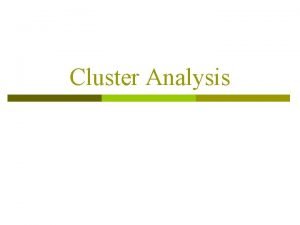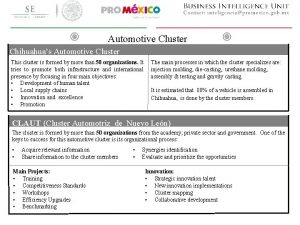The XMM Cluster Survey Project summary and Cosmology



















- Slides: 19

The XMM Cluster Survey: Project summary and Cosmology Forecasts Kathy Romer University of Sussex

XCS Collaboration • Institutes: Sussex, Porto, Edinburgh, Liverpool John Moore’s, Portsmouth, etc. • Students: Mark Hosmer, Nicola Mehrtens, Martin Sahlen, Ben Hoyle • Post. Doc’s: Ed Lloyd-Davies, John Stott, Matt Hilton (Durban) • Faculty: Collins, Kay (Manchester), Liddle, Mann, Miller (CTIO), Nichol, Stanford (UC Davis), Romer, Viana, West (ESO) • Funding: Institutes; STFC (UK); Chandra and XMM Guest Observing programmes (USA)

Talk Overview And related publications 1. Project Summary • • Romer et al. 2001 (9910217) Stanford et al. 2006 (0606075) Hilton et al. 2007 (0708. 3258) Collins et al. 2008 (submitted to Nature) 2. Cosmology Forecasts • Sahlen et al. (in press; 0802. 4462)

1. 1 Project Summary XCS is an X-ray cluster survey based on all XMM data in the public archive Goals – Cosmological parameters – Scaling Relations Distinguishing Features – – Area Selection function X-ray spectroscopy Added value science

1. 2 Justification for Goals • Parameters: – Clusters probe a different part of the parameter space to CMB and SNe • Scaling relations: – we need to know these relations to do cosmology – they tell us about structure formation – (see next talk)

1. 3 Features (Area) • Distinguishing Features – Area • 170 square degrees already • [conservative] prediction of 500 sq. deg by the end of XMM • These values account for overlaps and exclude regions unsuitable for cluster finding; in Galactic plane, near low-z clusters etc. Public (or soon to be public) XMM observations – Selection function – X-ray spectroscopy – Added value science

1. 4 Features (Selection Function) • Distinguishing Features – Area – Selection function • XCS is run using pipelines • we add fake clusters to test to the XCS sensitivity and build up selection functions • For Sahlen et al. 2008, we used simple analytical models, but recently we switched over to hydro-simulations Just one of the many XCS pipelines that convert data into the archive into catalogues of point sources and cluster candidates – X-ray spectroscopy – Added value science

1. 5 Features (Selection Function) • Distinguishing Features – Area – Selection function • XCS is run using pipelines • we add fake clusters to test to the XCS sensitivity and build up selection functions • For Sahlen et al. 2008, we used simple analytical models, but recently we switched over to hydro-simulations An XCS image before the addition of a fake cluster – X-ray spectroscopy – Added value science

1. 6 Features (Selection Function) • Distinguishing Features – Area – Selection function • XCS is run using pipelines • we add fake clusters to test to the XCS sensitivity and build up selection functions • For Sahlen et al. 2008, we used simple analytical models, but recently we switched over to hydro-simulations An XCS image after the addition (and detection) of a fake cluster – X-ray spectroscopy – Added value science

1. 7 Features (X-ray Spectroscopy) • Distinguishing Features – Area – Selection function – X-ray spectroscopy • ~300 XCS candidates were detected with 500 or more counts • 124 XCS 500 clusters have redshifts already • (see next talk) – Added value science The XCS L-T relation (see next talk)

1. 8 Features (Added value science) • Distinguishing Features – – Area Selection function X-ray spectroscopy Added value science • Rare object discovery: – Fossil Groups – High redshift clusters • Mass calibration for future cluster surveys: An XCS discovery of a Fossil Group – Dark Energy Survey – Planck • Galaxy Evolution • Quasar properties

1. 9 Features (Added value science) • Distinguishing Features – – Area Selection function X-ray spectroscopy Added value science • Rare object discovery: – Fossil Groups – High redshift clusters • Mass calibration for future cluster surveys: Combined J & K MOIRCS image of XMM XCSJ 2215 (z=1. 45) – Dark Energy Survey – Planck • Galaxy Evolution • Quasar properties

1. 10 Features (Added value science) • Distinguishing Features – – Area Selection function X-ray spectroscopy Added value science • Rare object discovery: – Fossil Groups – High redshift clusters • Mass calibration for future cluster surveys: Comparison of optical and X-ray properties for XCS (and 400 sq. deg) clusters in the SDSS region – Dark Energy Survey – Planck • Galaxy Evolution • Quasar properties

1. 11 Features (Added value science) • Distinguishing Features – – Area Selection function X-ray spectroscopy Added value science • Rare object discovery: – Fossil Groups – High redshift clusters • Mass calibration for future cluster surveys: An XCS Quasar: we have 100 with both optical and X-ray spectroscopy – Dark Energy Survey – Planck • Galaxy Evolution • Quasar properties

2. 1 Cosmology Forecasts XCS will deliver Omega-M to 10% and Sigma-8 to 6% These predictions: – Are based on a XCS 500 sample drawn from a 500 sq. deg survey – Assume a flat Universe – Use beta-model clusters for the selection function – Allow for errors in X-ray temperatures and photo-z’s – Include self-calibration of the luminosity-temperature relation – See 0802. 4462 for full details

2. 2 Cosmology Forecasts Understanding scaling relations is essential • We have made fake XCS catalogues using a variety of assumptions about scaling relations and find the catalogue properties vary significantly • Making the wrong assumptions when fitting for parameters distorts the results

2. 3 Cosmology Forecasts Understanding scaling relations is essential • We have made fake XCS catalogues using a variety of assumptions about scaling relations and find the catalogue properties vary significantly • Making the wrong assumptions when Assume the wrong scaling relation and fitting for parameters the correct parameter values can lie distorts the results outside the 90% confidence region!

2. 4 Cosmology Forecasts We are extending and improving the forecasts • Selection functions were based on simple beta models and flat geometry – Now we use hydro “clusters” – And non-flat cosmologies • We are forecasting for other surveys: contiguous XMM surveys; XEUS follow-up of XCS etc. • We need independent mass The inner black contours represent the estimates (e. g. from lensing) improvement in parameters if all XCS – XSC parameter constraints clusters have measured temperatures require an external M-Tx calibration (e. g. from XMM follow-up or XEUS)

Summary XCS is producing object catalogues for a variety of science applications
 Xmm multisim
Xmm multisim Secondary school xmm
Secondary school xmm Underage xmm
Underage xmm Cosmology
Cosmology Critical density
Critical density Scale factor cosmology
Scale factor cosmology Axis of evil cosmology
Axis of evil cosmology Definition of cosmology
Definition of cosmology Stav zalel
Stav zalel Dilaton
Dilaton Concordance model of cosmology
Concordance model of cosmology Cosmology
Cosmology Cosmology
Cosmology Newton cosmology
Newton cosmology Cosmology
Cosmology Intro to cosmology
Intro to cosmology Jainism
Jainism Career exploration vocabulary
Career exploration vocabulary Primary survey secondary survey
Primary survey secondary survey Hình ảnh bộ gõ cơ thể búng tay
Hình ảnh bộ gõ cơ thể búng tay
